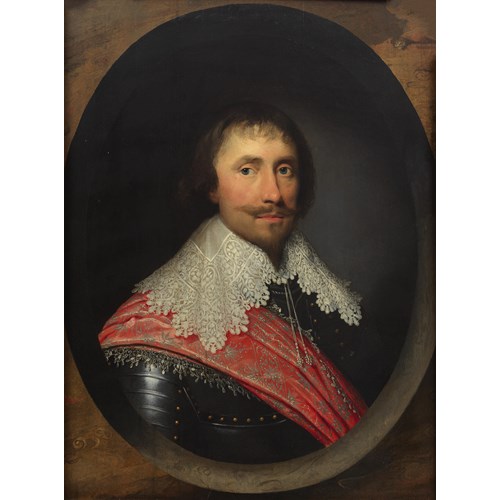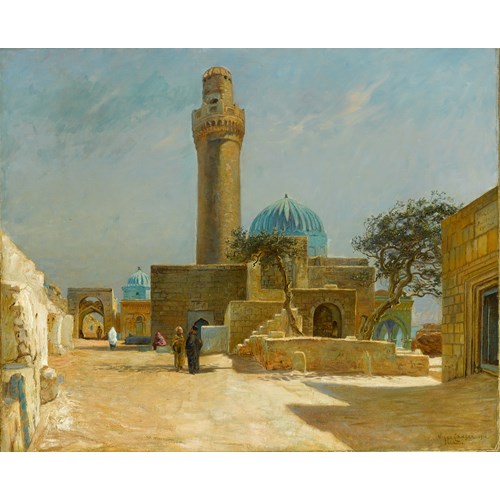Carel de Moor
Portrait of a Gentleman, Probably a Self-Portrait
Date 1688-1690
Period 1600-1750, 17th century
Origin The Netherlands
Medium Oil on canvas
Dimension 53.7 x 45 cm (21¹/₈ x 17³/₄ inches)
Pamela Fowler, author of the forthcoming catalogue raisonné of de Moor’s paintings, believes this work to be a self-portrait painted c. 1688-1690 to celebrate his first marriage. Leiden church records reveal de Moor married Hillegonda Woel in April 1688, and stylistically our portrait is consistent with paintings from that period.¹ The numerous symbolic references to love lend further credence to the idea that this was a marriage portrait, comparable to a work such as Ferdinand Bol’s self-portrait in the Rijksmuseum, painted on the occasion of his second marriage, and which also contains matrimonial iconography.² De Moor almost certainly painted a portrait of his new wife Hillegonda as a pendant to this work, however, this has yet to be identified.
De Moor painted self-portraits throughout his career, and they reflect his stylistic development over the years. A very early painting in the Rijksmuseum³ shows a youthful de Moor staring out at the viewer with the same self-confidence seen in the present work. The small format of this self-portrait (21.5 x 17cm), and the precision with which it is painted, shows that in the early stages of his career de Moor was working very much in the traditions of the Leiden fijnschilders (“fine-painters”). Our portrait shows de Moor in his artistic prime, having just been appointed headman of the Guild of St. Luke for the first time in 1688. By this stage, de Moor’s technique had started to become slightly freer and looser than many of his Leiden contemporaries, a development that culminated in the late, painterly self-portrait of 1703. All three of these self-portraits show how throughout his life, despite stylistic changes, de Moor consistently portrayed himself as a handsome, elegant figure. Details, such as the fashionable Japanese rok he wears in our painting, underline this graceful presentation.
The present work is typical example of de Moor’s portraiture during the late 1680s and early 1690s. The park landscape with brooding sky, was a favourite backdrop, generally combined with an architectural or sculptural motif in the foreground. Sculptures of Eros and a dolphin are found in several paintings, suggesting that de Moor may have had such a sculpture in his studio. Similarly the sumptuous rok, which de Moor wears in the present work, is used again in a portrait at Hopetoun House, Scotland. De Moor was a hugely successful portraitist and many of his most successful paintings have costumes, poses and settings that, as in our painting, contribute towards a sense of refinement and elegance.
De Moor was born in Leiden, the son of an art dealer and frame maker. According to Arnold Houbraken, he initially studied in Leiden with Gerrit Dou (1613-1675), before a period in Amsterdam with Abraham van den Tempel (c.1622-1672). He then returned to Leiden to study with Frans van Mieris the Elder (1635-1681), before completing his training under Godfried Schalcken (1643-1706) in Dordrecht. The influence of fijnschilders, such as Dou and van Mieris, is most overt in de Moor’s genre and narrative paintings, but is also evident in portraits such as the present work, where he delights in depicting the wide range of textures and surfaces, despite the less finished style. The most significant influence on de Moor’s portraiture was clearly Schalcken, who also often used rich colourful costumes, prominent hands in unusual poses, and atmospheric park landscapes as backdrops.
De Moor joined the Leiden Guild of St. Luke in 1683, and eleven years later, together with Willem van Mieris (1662-1747) and Jacob van Toorenvliet (1640-1719), founded the Leidse Tekenacademie, where artists could draw from live models. Despite success in other genres, he focused increasingly on portraiture, and his reputation extended across Europe. Charles VI, The Holy Roman Emperor (1685-1740), knighted de Moor in 1714, and he is also thought to have been patronised by Peter the Great of Russia (1672-1725). During his lifetime de Moor was considered one of the greatest Dutch painters, and this self-portrait shows him newly married and entering his artistic prime.
We are grateful to Pamela Fowler for her assistance cataloguing the present work. Ms. Fowler will include the painting in her forthcoming catalogue raisonné of Carel de Moor’s paintings.
¹ Erfgoed Leiden (Netherlands) - Church records marriages, Nederlands Hervormd Ondertrouw (1575-1795), Part: 24, Period: 1686-1690, Leiden, archive 1004, inventory number 24, NH Ondertrouw Z. February 1686 - April 1690., folio Z – 158.
² Rijksmuseum, Amsterdam, inv. no. SK-A-42. Bol leans against a statue of Cupid, and additionally the original frame has a carved sunflower, a reference to his devotion to his wife.
³ Rijksmuseum, Amsterdam, inv. no. SK-A-1746
Date: 1688-1690
Period: 1600-1750, 17th century
Origin: The Netherlands
Medium: Oil on canvas
Signature: Signed ‘D.Moor’ (centre left).
Dimension: 53.7 x 45 cm (21¹/₈ x 17³/₄ inches)
Provenance: Possibly Tibout Regters (1710 – 1768);
Possibly his posthumous sale, Hendrik de Winter and Jan Yver, Amsterdam, 18 April 1768, lot 5;
Lancelot Wedderburn, Esq. (or Wetherburn), by 1868;
anonymous sale, Christie’s, Manson & Woods, 14th December 1907, lot 71;
anonymous sale, Dobuaschofsky, Bern, Switzerland, 24th October 1997, lot 818.
Literature: Ralph N. James and L. Lefèvre, National Exhibition of Works of Art, at Leeds, 1868, exh. cat. (Leeds, Edward Baines and Sons, 1868), p.47, no. 679;
to be included in Pamela Fowler’s forthcoming catalogue raisonné of Carel de Moor’s paintings.
Exhibition: Leeds, England, 1968, National Exhibition of Works of Art, at Leeds, 1868, no. 679.
More artworks from the Gallery




 A Woman Bending forwards in Work, and_T638856835938571470.jpg?width=500&height=500&mode=pad&scale=both&qlt=90&format=jpg)



_T638803087933826238.jpg?width=500&height=500&mode=pad&scale=both&qlt=90&format=jpg)
